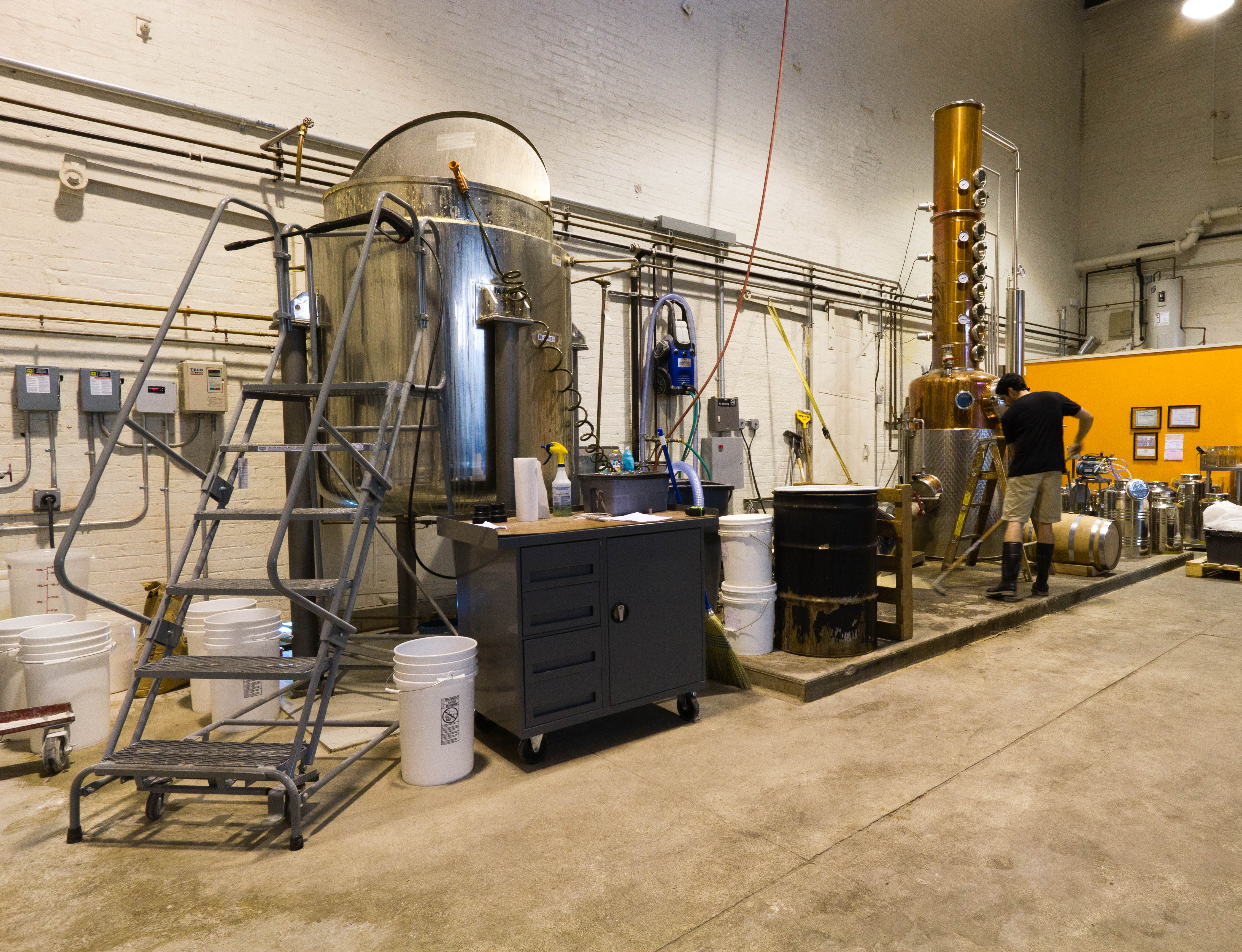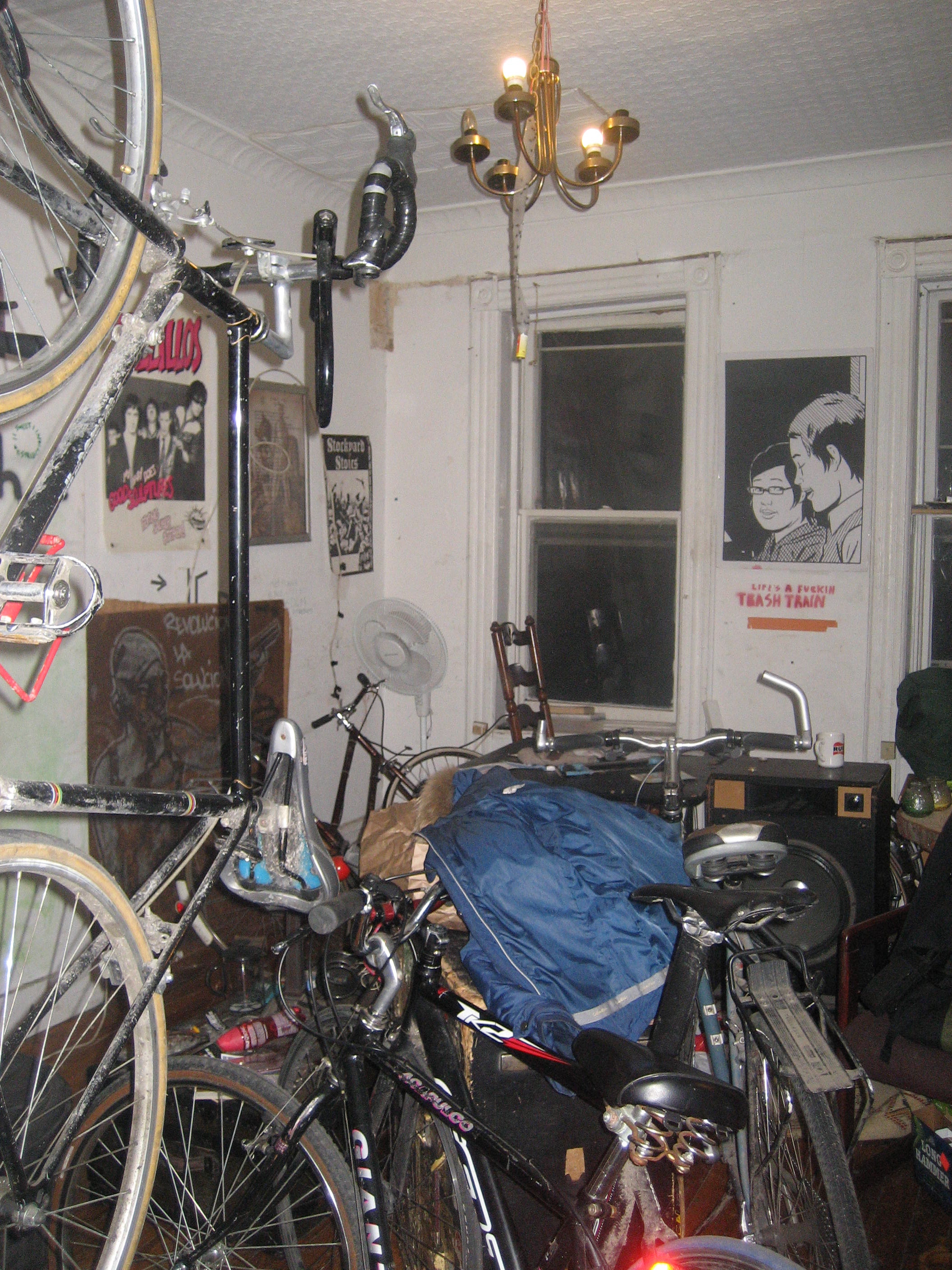breuckelen distilling co.
neighborhood: sunset park | space type: commercial | active since: 2010 | links: website, facebook, twitter
Brooklynites are makers. We make everything, no matter how weird or difficult. We make gardens in abandoned lots, screen-printed skateboards, pools in dumpsters, art from old books, games out of shopping carts. So of course we’re also making booze. There’s beer from Brooklyn Brewery and Sixpoint, wine from Brooklyn Winery, and a handful of small distilleries making harder stuff: Kings County Distillery in Bushwick, New York Distilling Co. in Williamsburg, and Breuckelen Distilling Company in Sunset Park.
Housed in a former boiler room—which used to contain a massive coal-fired furnace that steam-heated the surrounding buildings during the Industrial Revolution—Breuckelen offers a selection of gins and whiskeys. They make all their spirits on the premises, from scratch, using organic ingredients sourced from within New York State. And they do it all themselves, from milling the grains to corking the bottles. You can buy their spirits in bars and liquor stores around New York City (and in a few other states), and you can sample them at the distillery: they have tastings every Saturday from 12 to 6—for only $3, refundable if you buy a bottle—and they pair their gin with Q Tonic, also from Brooklyn.
So how’s this stuff made? I didn’t know, so in case you don’t either, here’s a simple rundown. Breuckelen’s spirits start with organic, whole-grain wheat from Upstate New York. This is milled into flour, which gets dumped into a huge masher, mixed with water and natural enzymes, heated, and then cooled. Next they add yeast and pump it into fermentor tanks (which smell just like baking bread!). What comes out is like a crude form of beer. That’s loaded into their custom still, which heats the mash gently and evenly. During the fermenting process, the spirit that comes off first isn’t palatable, so Brad and Co. smell and, eventually, taste the first few jars to determine when the alcohol is good to drink.
 At this point, the spirit can become either gin or whiskey. The gin is re-distilled with juniper berries, lemon peels, ginger, rosemary, and grapefruit. The whiskey is aged in charred oak barrels, which gives it a maple syrup flavor, along with the yeasty taste of the wheat; Brad says it tastes like a pancake breakfast. Finally, the spirits are diluted with NYC tap water, bottled, and corked. Neat!
At this point, the spirit can become either gin or whiskey. The gin is re-distilled with juniper berries, lemon peels, ginger, rosemary, and grapefruit. The whiskey is aged in charred oak barrels, which gives it a maple syrup flavor, along with the yeasty taste of the wheat; Brad says it tastes like a pancake breakfast. Finally, the spirits are diluted with NYC tap water, bottled, and corked. Neat!
 brooklyn spaces: So are you a huge gin drinker? What made you decide to do this?
brooklyn spaces: So are you a huge gin drinker? What made you decide to do this?
Brad: Yeah, I like gin, I like whiskey. That was one of the things that was important to me, to make something that I appreciate. I had this other job where I wasn’t making anything, and I saw all these people in Brooklyn making stuff, taking something and transforming it into something totally different, whether it’s turning steel into a knife, turning flour into bread, or turning coffee beans into the second most delicious thing in the world. I wanted to do something like that, to make a contribution. Then one day I read an article about how the federal government had recently relaxed some of the rules and now it was financially possible to have a small distillery. It sounded perfect, to do something totally my own, whether it’s good, bad, popular, unpopular; it would taste of the ingredients we used, and of the processes we designed to make it. I decide to try it, and things sort of came together.
 brooklyn spaces: How did you know how to get started?
brooklyn spaces: How did you know how to get started?
Brad: I read some books, then I visited some small distilleries, like Koval in Chicago. Kothe, who made the still for us, puts on some classes, so I took one of those. I also did a lot of drinking to understand the different spirits, why they taste the way they do. And then just a lot of experimentation.
 brooklyn spaces: How did you find this space?
brooklyn spaces: How did you find this space?
Brad: I knew I needed sixteen-foot ceilings because the still was going to be so tall. My real estate agent told me about this space, but she said it in passing, like, “Well, there’s one other place with high ceilings, but it’s not in the right neighborhood for you. You can go look at it in your spare time if you want.” So I rode my bike down here, and I remember coming under the BQE; with all that construction, it felt like a war zone. The neighborhood seemed a little desolate, but the space was beautiful, and I knew it was a good fit. And then once I started coming down here, I realized there are actually a lot of really cool, friendly people doing great things around here. A couple doors down is Object Metal, they makes gorgeous furniture; next door Kevin Barrett is doing amazing abstract metal sculpture; down the block is Pawz, a company that makes rubber dog booties, which my dog uses all the time and they’re awesome. There’s a bunch of other artist studios next door, and nearby there’s Cut Brooklyn, who makes knives, Sway Space Letterpress, and Lite Brite Neon.
 brooklyn spaces: So it’s a good community?
brooklyn spaces: So it’s a good community?
Brad: Yeah, it’s really awesome, really friendly. After I rented the space, one of the first things I bought was the forklift, and I had it delivered in the middle of the night, because that was cheaper. So the guy shows up at three in the morning, we unload the forklift, and I try to bring it inside. It’s a used lift, and the guys who had it before had modified it by welding a section on the top, so even though I’d checked the height online, it didn’t fit through my doors. Kevin wound up storing it for me for three months while I got the doors replaced. So yeah, there’s a great community down here.
 brooklyn spaces: I feel like there’s almost an unprecedented surge of creativity in Brooklyn right now. Do you think Brooklyn attracts people who want to do things like this?
brooklyn spaces: I feel like there’s almost an unprecedented surge of creativity in Brooklyn right now. Do you think Brooklyn attracts people who want to do things like this?
Brad: Definitely. For me it was just being here and realizing how great it was and deciding I wanted to be part of it. It really made me rethink my path. The whole idea of Brooklyn, it was inspiring to see people doing these crazy, ridiculous, but really authentic projects, independent of some giant organization. And people support that here, too; I used to bike three miles to get the coffee beans that I like.
 brooklyn spaces: What are your goals for the future of the space?
brooklyn spaces: What are your goals for the future of the space?
Brad: To survive. To keep making better gins and whiskeys. We’re working on a jenever-style gin, and a barrel-aged one, gin aged in an oak barrel like a whiskey. I have a couple other ideas for different flavors that I want to try. The whole project is a big experiment, trying to figure out how to keep making it better and better.
Like this? Read about more makers: Metropolis Soap, Urbanglass, Ugly Duckling Presse, Twig Terrariums








